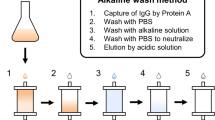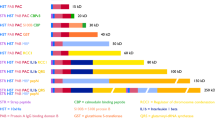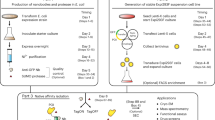Abstract
Eucaryotic proteins expressed intracellularly in Escherichia coli are frequently sequestered in insoluble inclusion bodies that must be solubilized prior to protein purification. Treatment of bacterial lysates with ion exchange resin has been found to solubilize 3 different recombinant proteins: an SV40 T antigen peptide Th encompassing the DNA binding do main of the intact protein, human interleukin 2, and the retroviral v-myb oncoprotein. The well-defined activities of peptide Th and interleukin were recovered in whole or in part in the solubilized proteins. This procedure may be generally applicable to the purification of insoluble recombinant proteins from E. coli or other expression systems.
This is a preview of subscription content, access via your institution
Access options
Subscribe to this journal
Receive 12 print issues and online access
$209.00 per year
only $17.42 per issue
Buy this article
- Purchase on Springer Link
- Instant access to full article PDF
Prices may be subject to local taxes which are calculated during checkout
Similar content being viewed by others
References
Marston, F.A.O. 1986. The purification of eukaryotic polypeptides synthesized in Escherichia coli. Biochem. J. 240:1–12.
Ollo, R. and Maniatis, T. 1987. Drosphila Krüppel gene product produced in a baculovirus expression system is a nuclear phospho protein that binds to DNA. Proc. Natl. Acad. Sci. USA 84:5700–5704.
Williams, D.C., Van Frank, R.M., Muth, W.L., and Burnett, J.P. 1982. Cytoplasmic inclusion bodies in Escherichia coli producing bio-synthetic human insulin proteins. Science 215:687–689.
Paul, D.c., Van Frank, R.M., Muth, W.L., Ross, J.C., and Williams, D.C. 1983. Immunocytochemical demonstration of human proinsulin chimeric polypeptide within cytoplasmic inclusion bodies of Escherichia coli. Eur. J. Cell Biol. 31:171–174.
Lowe, P.A., Rhind, S.K., Sugrue, R., and Marston, F.A.O. 1987. Solubilisation, refolding and purification of eukaryotic proteins expressed in E. coli, p. 429–442. In: Protein Purification: Micro to Macro, R. Burgess, (Ed.). Alan R. Liss, Inc., New York.
Marston, F.A.O. 1987. The purification of eukaryotic polypeptides expressed in Escherichia coli, p. 59–88. In: DNA Cloning, Vol. III. D. Glover (Ed.). IRL Press, Oxford.
Arthur, A.K., Höss, A., and Fanning, E. 1988. Expression of simian virus 40 T antigen in Escherichia coli: Localization of T-antigen origin DNA-binding domain to within 129 amino acids. J. Virol. 62:1999–2006.
Hartmann, G.R., Heinrich, P., Kollenda, M., Skrobranek, B., Trop-schug, M., and Weiβ, W. 1985. Molecular mechanism of action of the antibiotic rifampicin. Angew. Chemie 24:1009–1014.
Gillis, S., Ferm, M., Ou, W., and Smith, K. 1978. T-cell growth factor: parameters of production and a quantitative microassay for activity. J. Immunol. 120:2027–2032.
Messing, J., Crea, R., and Seeburg, P.H. 1981. A system for shotgun DNA sequencing. Nucleic Acids Res. 9:309–321.
Boyer, H.W. and Roulland-Dussoix, R. 1969. A complementation analysis of the restriction and modification of DNA in Escherichia coli. J. Mol. Biol. 41:459–472.
Goff, S.A., Casson, L.P., and Goldberg, A.L. 1984. Heat shock regulatory gene htpR influences rates of protein degradation and expression of the lon gene in Escherichia coli. Proc. Natl. Acad. Sci. USA 81:6647–6651.
Klempnauer, K.-H. and Sippel, A.E. 1987. The highly conserved amino terminal region of the protein encoded by the v-myb oncogene functions as a DNA binding domain. EMBO J. 6:2719–2725.
Harlow, E., Crawford, L.V., Pim, D.C., and Williamson, N.M. 1981. Monoclonal antibodies specific for simian virus 40 tumor antigens. J. Virol. 39:861–869.
Kniep, B., Hünig, T.R., Fitch, F.W., Heuer, J., Kölsch, E., and Mühlradt, P. 1983. Neutral glycosphingolipids of murine myeloma cells and helper, cytolytic, and suppressor T-lymphocytes. Biochemistry 22:251–255.
Runzler, R., Thompson, S., and Fanning, E. 1987. Oligomerization and origin DNA-binding activity of simian virus 40 large T antigen. J. Virol. 61:2076–2083.
Author information
Authors and Affiliations
Rights and permissions
About this article
Cite this article
Hoess, A., Arthur, A., Wanner, G. et al. Recovery of Soluble, Biologically Active Recombinant Proteins from Total Bacterial Lysates Using Ion Exchange Resin. Nat Biotechnol 6, 1214–1217 (1988). https://doi.org/10.1038/nbt1088-1214
Received:
Accepted:
Issue Date:
DOI: https://doi.org/10.1038/nbt1088-1214
This article is cited by
-
Removal of a Proteolytic Activity Associated with Aggregates Formed from Expression of Creatine Kinase in Escherichia coli Leads to Improved Recovery of Active Enzyme
Nature Biotechnology (1990)
-
Folding proteins
Nature (1990)
-
Production of Soluble Recombinant Proteins in Bacteria
Nature Biotechnology (1989)



